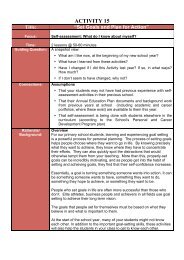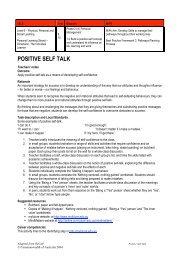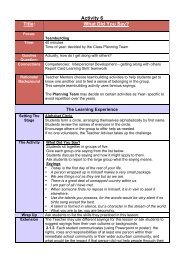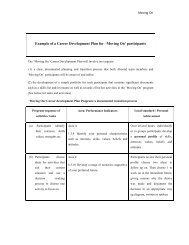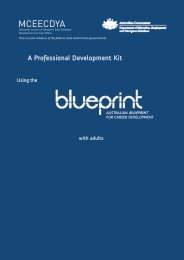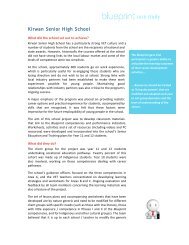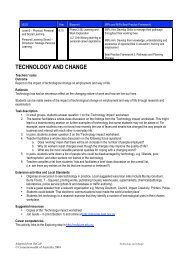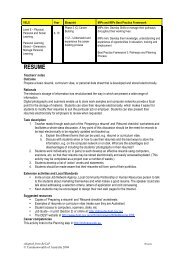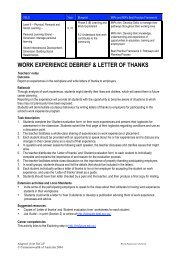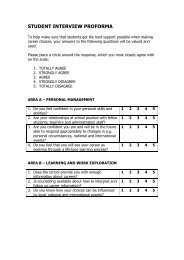Download - Blueprint - Australian Blueprint for Career Development
Download - Blueprint - Australian Blueprint for Career Development
Download - Blueprint - Australian Blueprint for Career Development
You also want an ePaper? Increase the reach of your titles
YUMPU automatically turns print PDFs into web optimized ePapers that Google loves.
MIPs Best Practice Framework<br />
1. Whole School Management<br />
Best Practice Framework<br />
Current Situation<br />
Rate and Comment<br />
(High) 5 4 3 2 1 (Low)<br />
Ideas <strong>for</strong> strategies<br />
School Cluster<br />
Planning Planning<br />
1.1 Senior staff in the school demonstrate a broad view about what MIPs can achieve, and regard the MIPs<br />
objectives as part of a school’s core business. While external agencies might be brought in to provide services<br />
or some aspects might be outsourced, the school retains responsibility <strong>for</strong> MIPs outcomes.<br />
1.2 Senior school leadership demonstrates strong support <strong>for</strong> and involvement with MIPs staff and ensures that<br />
strategies <strong>for</strong> achieving MIPs outcomes are incorporated into whole school curriculum planning.<br />
1.3 A MIPs team operates within the school consisting of those with roles dealing with students in the postcompulsory<br />
years (VCE, VET, VCAL, and senior school coordinators, and assistant principals).<br />
2. Coordinated Delivery<br />
2.1 An integrated model of support delivery that includes MIPs, careers and student welfare improves collective<br />
knowledge of student needs and aspirations.<br />
2.2 Within the MIPs team there is an identifiable point of coordination of pathways planning and case management<br />
reporting to the school and community on the effectiveness of pathways planning and case management.<br />
2.3 The response to the data and in<strong>for</strong>mation produced through pathways planning strengthens the capacity of<br />
school staff to understand the diverse needs of the student population, and drives appropriate and relevant<br />
program provision.<br />
3. Pathways Planning Processes<br />
3.1 There is recognition that student engagement and retention are issues commencing be<strong>for</strong>e the post-compulsory<br />
years, and the school has developed strategies using the new Victorian Essential Learning Standards to embed<br />
pathways planning across all year levels.<br />
3.2 The pathway plans developed are comprehensive in their nature and regularly monitored to ensure they remain<br />
relevant.<br />
3.3 Pathway plans are used within the school in ways that lead students to access, value, identify with and<br />
ultimately retain their plans. Students retain their plan when they leave or transfer to another school.<br />
3.4 Effective parental involvement is sought and encouraged by school staff as part of a process of continuous<br />
improvement.<br />
4. Students at risk




